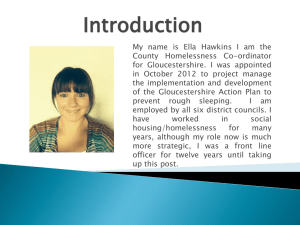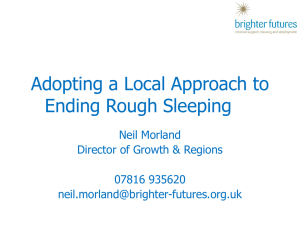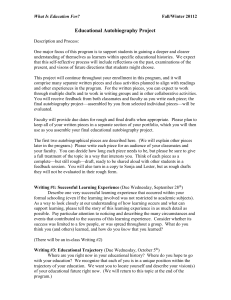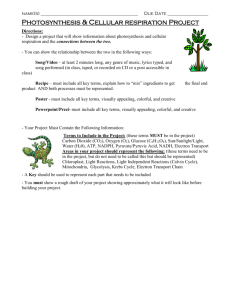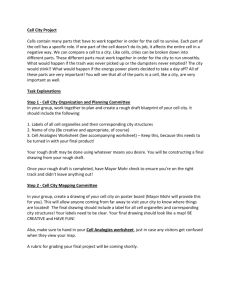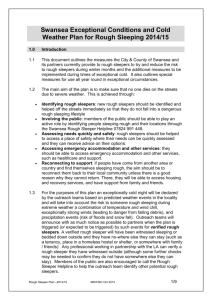Severe Weather Emergency Protocols: Making arrangements to
advertisement
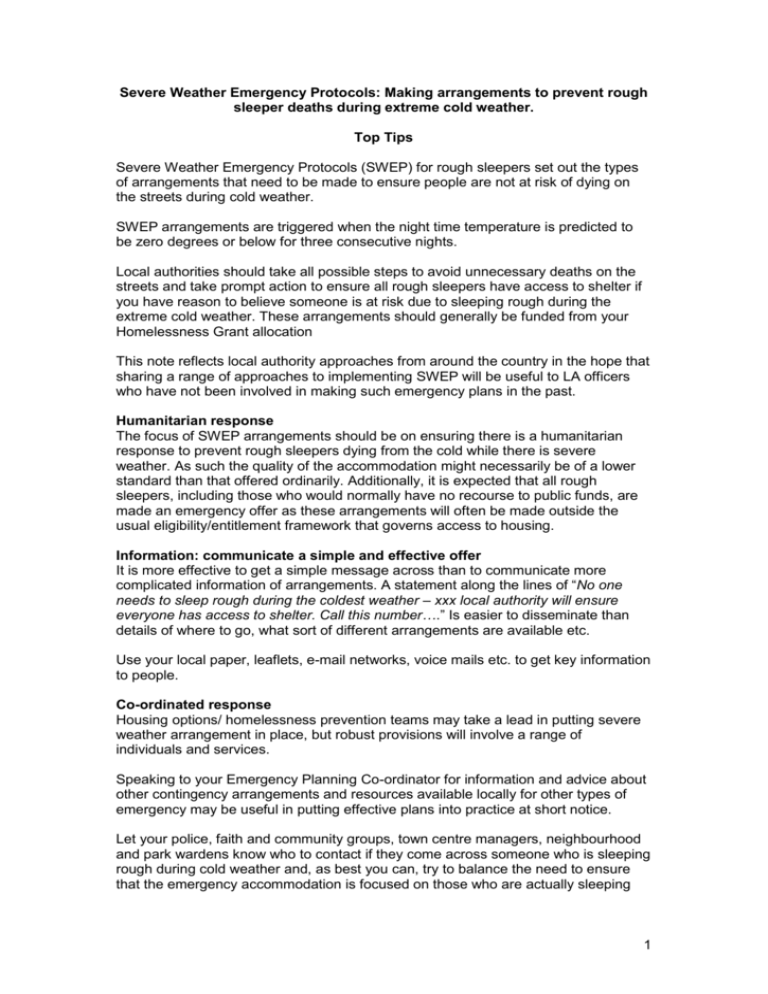
Severe Weather Emergency Protocols: Making arrangements to prevent rough sleeper deaths during extreme cold weather. Top Tips Severe Weather Emergency Protocols (SWEP) for rough sleepers set out the types of arrangements that need to be made to ensure people are not at risk of dying on the streets during cold weather. SWEP arrangements are triggered when the night time temperature is predicted to be zero degrees or below for three consecutive nights. Local authorities should take all possible steps to avoid unnecessary deaths on the streets and take prompt action to ensure all rough sleepers have access to shelter if you have reason to believe someone is at risk due to sleeping rough during the extreme cold weather. These arrangements should generally be funded from your Homelessness Grant allocation This note reflects local authority approaches from around the country in the hope that sharing a range of approaches to implementing SWEP will be useful to LA officers who have not been involved in making such emergency plans in the past. Humanitarian response The focus of SWEP arrangements should be on ensuring there is a humanitarian response to prevent rough sleepers dying from the cold while there is severe weather. As such the quality of the accommodation might necessarily be of a lower standard than that offered ordinarily. Additionally, it is expected that all rough sleepers, including those who would normally have no recourse to public funds, are made an emergency offer as these arrangements will often be made outside the usual eligibility/entitlement framework that governs access to housing. Information: communicate a simple and effective offer It is more effective to get a simple message across than to communicate more complicated information of arrangements. A statement along the lines of “No one needs to sleep rough during the coldest weather – xxx local authority will ensure everyone has access to shelter. Call this number….” Is easier to disseminate than details of where to go, what sort of different arrangements are available etc. Use your local paper, leaflets, e-mail networks, voice mails etc. to get key information to people. Co-ordinated response Housing options/ homelessness prevention teams may take a lead in putting severe weather arrangement in place, but robust provisions will involve a range of individuals and services. Speaking to your Emergency Planning Co-ordinator for information and advice about other contingency arrangements and resources available locally for other types of emergency may be useful in putting effective plans into practice at short notice. Let your police, faith and community groups, town centre managers, neighbourhood and park wardens know who to contact if they come across someone who is sleeping rough during cold weather and, as best you can, try to balance the need to ensure that the emergency accommodation is focused on those who are actually sleeping 1 rough with the need to act swiftly to accommodate people without lengthy assessment processes and lots of hurdles. Make the most of your existing accommodation resources You may not need to set up new services from scratch – but can make the most of existing facilities and resources. For example: You could use communal rooms in existing hostels or winter shelters (provided by voluntary sector agencies, churches or local authorities) to put up people who would otherwise be sleeping rough. You may wish to use mattresses on the floor, camp beds, or simply provide arm chairs in a safe warm space for people to use. You could use your existing temporary accommodation for a short period of time – outside the usual access arrangements for humanitarian reasons. Some local authorities do this during the year for selected rough sleepers who are waiting for supported accommodation and would otherwise be on the streets. You could use day centres or rooms in community centres or church halls to provide basic shelter at night. Again, this may involve mattresses on the floor, camp beds, or arm chairs. Some rural areas have used static caravans – ensuring they have heating – as safe havens for rough sleepers You could use B&B – some local authorities have existing block contract arrangements that they extend to include people who would otherwise be sleeping rough. B&B may be more expensive, but it can offer flexibility and is easier to access than negotiating and making arrangements such as the above. Using existing accommodation and facilities may still involve additional resources such as: Extra staffing – even hostels with 24 hour cover may need to increase staffing levels (e.g. use waking staff; have an additional on site staff member) to manage the increased number of people using the service, especially where less is known about some of the individuals than would normally be the case. Using day centres, community centres and church halls etc. will usually require additional staffing – you may be able to use a mix of experienced staff and volunteers. You will need to ensure that extra bedding/ mattresses and food is available, as well as toiletries and towels. A hot evening meal is important if the provision is only available during the night, as people may be cold and hungry when they arrive. Additional resources and considerations Some rough sleepers may have specific needs to consider: Personal care. Some very entrenched rough sleepers may have poor personal care. Additional support – including cleaning and assistance with 2 self care and laundry – may be important to help people keep their accommodation – even where B&B is being used. Couples. Some rough sleepers have partners and will want to be accommodated as a couple. In emergencies, single or double rooms could be used for couples. This is harder to manage where accommodation is in dormitory style – but you may wish to consider short term B&B placements if the alternative is to leave people on the streets. Dogs. Some rough sleepers may have dogs. Ideally, you may be able to negotiate with hostel providers to accept dogs for a short period (there are good policies and guidelines for managing dogs available at the National Canine Defence League’s website). You may also be able to use your TA – including units that can accept dogs. You may be able to find volunteers to accommodate a dog for a short period if time, and bring it to a central location each day to reunite it with their owner. If the only way to ensure someone comes in from the extreme cold is to house their dog, then arrangements for kennelling may be considered. People refusing hostels. Some rough sleepers have had poor past experiences of hostels and may be entrenched living on the street. Others may have complex needs and feel vulnerable (or pose risks to others) in communal settings. These individuals are often hard to engage and using B&B has been found by many local authorities as a good way of helping this process, and reducing the likelihood of someone returning to the streets. Exclusions. Despite the best management and support, it is likely that there will still be incidents and challenging or threatening behaviour in some services. Services should seek to manage risks and focus on inclusion policies which minimise the likelihood of someone being excluded from services. This may include moving people between different services or increasing staffing levels and providing additional specialist support. If this is not possible, then any exclusions should only be made on a night be night basis – with no lengthy bars. Where someone is excluded, sign-posting people towards basic shelter, providing sleeping bags and asking police or outreach teams to check on them will provide some safeguards. Refusing help. The extreme cold weather increases the risk of death or serious illness to people who sleep rough. Given this, a refusal to accept accommodation may be new grounds to trigger referrals to services for mental health assessments. 3
